Japan Oral Anti-Diabetic Drug Market Size
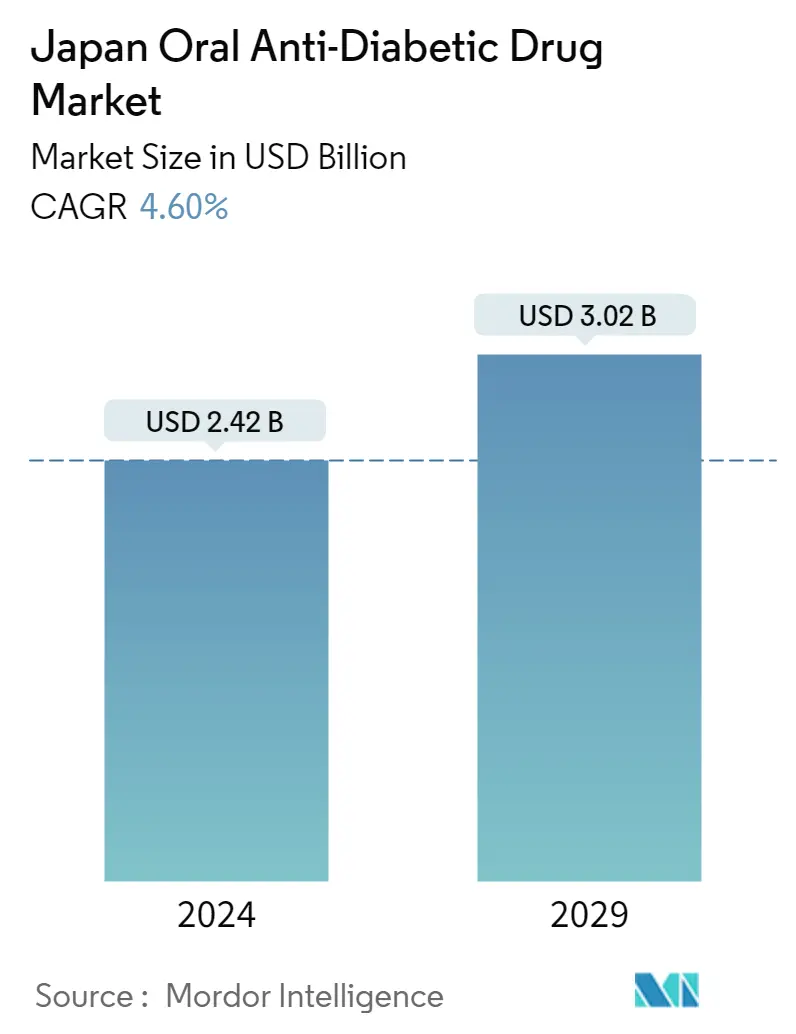
| Study Period | 2019 - 2029 |
| Base Year For Estimation | 2023 |
| Forecast Data Period | 2024 - 2029 |
| Market Size (2024) | USD 2.42 Billion |
| Market Size (2029) | USD 3.02 Billion |
| CAGR (2024 - 2029) | 4.60 % |
Major Players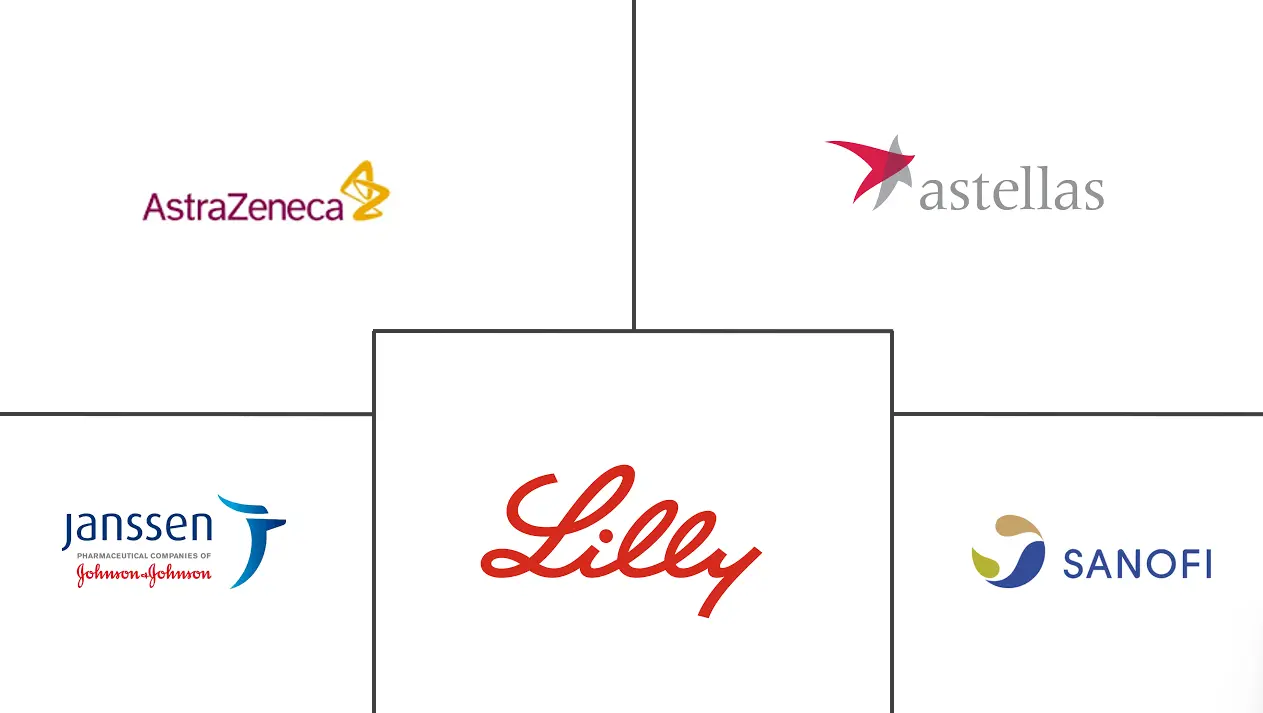
*Disclaimer: Major Players sorted in no particular order |
Need a report that reflects how COVID-19 has impacted this market and its growth?
Japan Oral Anti-Diabetic Drug Market Analysis
The Japan Oral Anti-Diabetic Drug Market size is estimated at USD 2.42 billion in 2024, and is expected to reach USD 3.02 billion by 2029, growing at a CAGR of 4.60% during the forecast period (2024-2029).
Japanese victims of the COVID-19 pandemic were less numerous than those from other nations, which may be related to genetic variations, features of Japanese culture, and differences in the coagulation system between Japanese and Caucasians. The Osaka Prefectural Government categorized patients as mild, moderate, or severe and assigned them to various alternative accommodations in order to ease hospital overpopulation. Hospitals provide patient care in accordance with national government regulations. They focused on individuals with intermediate conditions or those with acceptable oxygen saturation values despite the presence of symptoms on computed tomography. Type 2 diabetes is linked to a sedentary lifestyle, which fosters the development of innate insulin resistance, in contrast to Type 1 diabetes, which is brought on by immune system dysfunction.
Japan's rising older population, who are more susceptible to disease, as well as an increase in obesity brought on by inactivity and irregular eating patterns, are regarded to be contributing factors to the country's rising diabetes incidence. As a result of being referred to a medical facility based on the findings of the metabolic syndrome examination, which was implemented in 2008 to avoid lifestyle-related disorders, more people have been diagnosed with the disease, which is another factor. With an aging population, diabetes cases are predicted to increase even more in Japan.
Globally, diabetes has become an epidemic; the IDF 2021 estimates that there are 11 million diabetics in Japan. Type 2 diabetes is linked to a sedentary lifestyle, which fosters the development of innate insulin resistance, in contrast to Type 1 diabetes, which is brought on by immune system dysfunction. Hence, Type 1 diabetes can be categorized as insulin-requiring diabetes, whereas Type 2 diabetes can be categorized as insulin-dependent diabetes. As one of the largest geriatric populations in the world, Japan is particularly susceptible to developing type 2 diabetes. With an aging population, diabetes is becoming more prevalent in Japan. Monitoring and controlling blood sugar levels are becoming more common in order to prevent harmful effects, including cardiovascular disease, kidney diseases, and other conditions.
Japan Oral Anti-Diabetic Drug Market Trends
Sodium - glucose cotransport -2 (SGLT-2) inhibitor Segment Occupied the Highest Market Share in the Japan Oral Anti-Diabetic Drugs Market in 2022
In 2020, dapagliflozin and empagliflozin received approval for treatment in patients with persistent symptomatic heart failure in Japan. These medications are sodium-glucose cotransporter 2 (SGLT2) inhibitors. This authorization means that a new significant group of patients is becoming eligible for therapy with an SGLT2 inhibitor following the rapid growth of prescriptions for SGLT2 inhibitors for patients with type 2 diabetes mellitus who also have a very high cardiovascular risk. Type 2 diabetes is related to adopting a sedentary lifestyle, which results in the development of innate resistance to insulin, in contrast to Type 1 diabetes, which is brought on by an immune system failure. As a result, Type 1 diabetes is known as insulin-required diabetes, and Type 2 diabetes is known as insulin-dependent diabetes. One of the greatest elderly populations in the world is found in Japan, where type 2 diabetes is more likely to develop. As Japan's population continues to age, diabetes is becoming more common. Blood glucose levels are increasingly being monitored and managed in order to prevent adverse effects like cardiovascular disorders. Throughout, the incidence of type-2 diabetes is increasing, which boosts demand for SGLT2 drugs. Prices are comparatively high in this location. Jardiance holds a 50% market share in the SGLT2 market in the US. Only one diabetic drug, Jardiance's active pharmacological component, lowers the risk of cardiovascular death in people with Type-2 diabetes.
Owing to the aforementioned factors, the market is expected to grow during the forecast period.
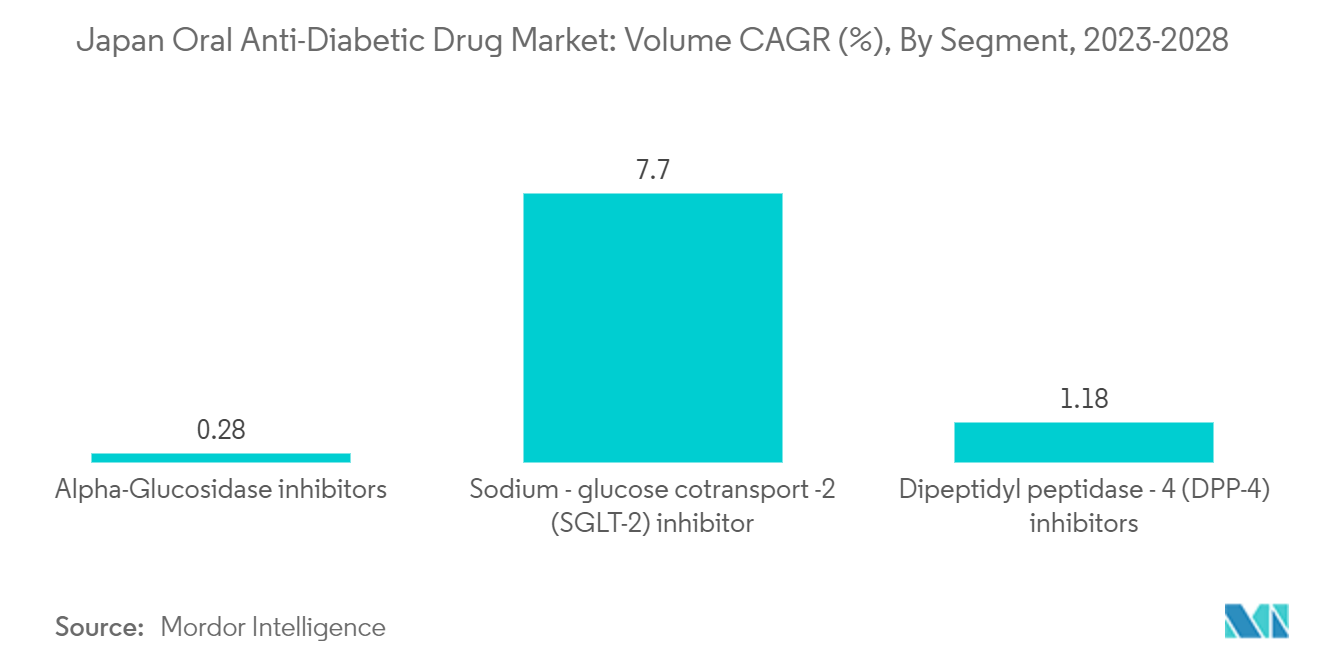
Increasing Diabetes Population in Japan is driving the market.
In January 2021, an article was published, 'Current trends in diabetes mellitus database research in Japan,' funded by AstraZeneca and Ono Pharmaceutical Co., Ltd., stated that East Asians tend to develop type 2 diabetes mellitus with a lower mean body mass index (BMI) compared with that in Caucasians, concomitantly having a greater amount of body fat with a tendency of visceral adiposity at any BMI. In Japanese patients, diabetes develops at a younger age and is characterized by early β-cell dysfunction with the coexistence of insulin resistance due to increased visceral adiposity.
According to an article published in 2022, 'Dietary Patterns and New-Onset Type 2 Diabetes Mellitus in Evacuees after the Great East Japan Earthquake: A 7-Year Longitudinal Analysis in the Fukushima Health Management Survey', there is evidence of associations between dietary behaviors or diet quality indices, food groups, single foods, and beverages, specific macronutrients and micronutrients, and the incidence of type 2 diabetes mellitus in Japan. Dietary patterns are considered to play a role in the onset or prevention of type 2 diabetes mellitus. The westernized diet makes Japanese people more prone to developing type 2 diabetes mellitus. While traditional Japanese food is characterized by low fat and calorie content, a shift in people's preference for processed food with higher animal fat and calories is thought to have increased abdominal adiposity.
It is therefore anticipated to drive the category expansion during the forecast period because of the aforementioned factors.
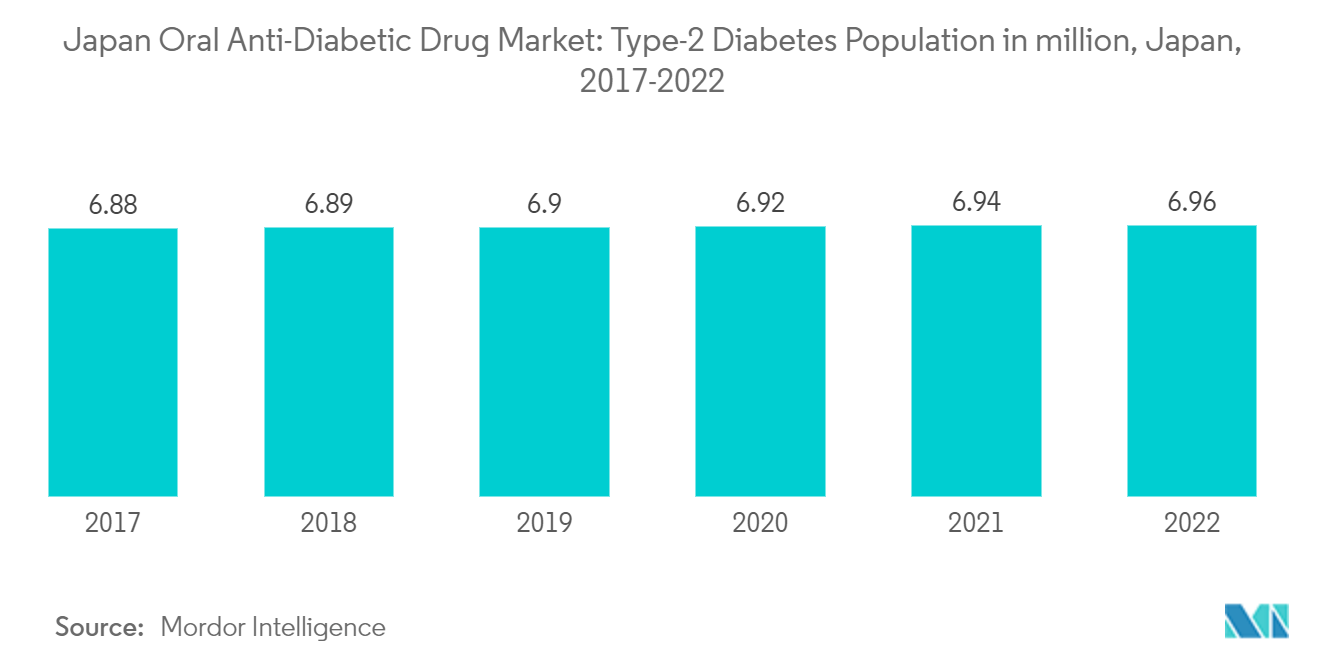
Japan Oral Anti-Diabetic Drug Industry Overview
The Japan oral anti-diabetes drug market is consolidated, with a few major manufacturers like Eli Lilly, AstraZeneca, Sanofi, and Janssen Pharmaceuticals having a global market presence. In contrast, the remaining manufacturers are confined to the other local or regional markets. Companies are focusing on innovations in diabetes drugs.
Japan Oral Anti-Diabetic Drug Market Leaders
Sanofi
Eli Lilly
Astrazeneca
Janseen
Astellas
*Disclaimer: Major Players sorted in no particular order
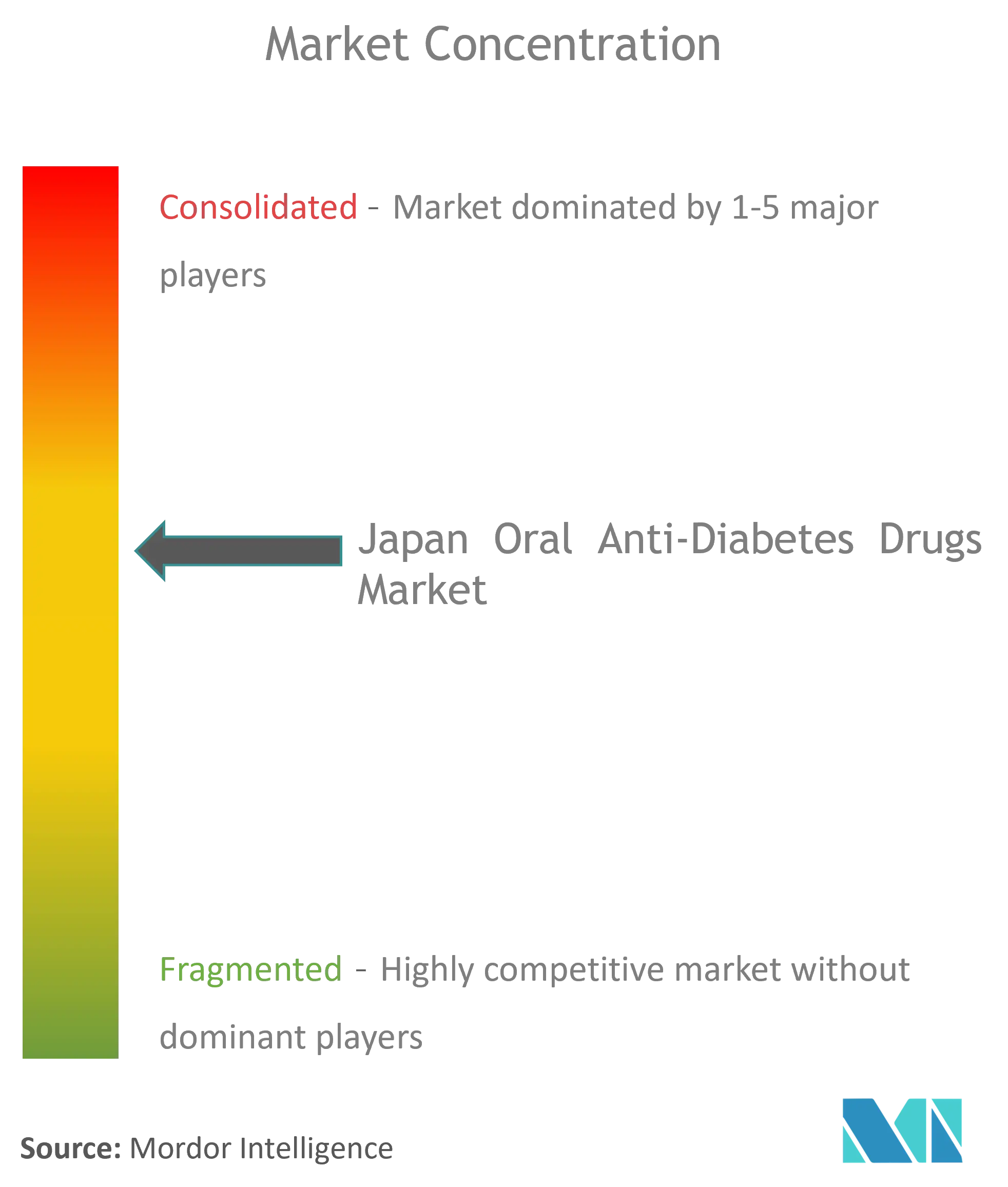
Japan Oral Anti-Diabetic Drug Market News
- June 2022: Sanofi and Health2Sync announced that they would work together on new features such as connected caps for insulin products that can automatically record delivered doses, rather than requiring them to be logged manually, and titration alerts from the app to indicate when a change in insulin dose may be required.
- Dec 2021: Sumitomo Dainippon Pharma launched Twymeeg (imeglimin hydrochloride) in Japan, the first launch of the diabetes drug. This drug is an oral hypoglycemic agent in a new chemical class of tetrahydro triazine-containing molecules.
Japan Oral Anti-Diabetic Drug Market Report - Table of Contents
1. INTRODUCTION
1.1 Study Assumptions and Market Definition
1.2 Scope of the Study
2. RESEARCH METHODOLOGY
3. EXECUTIVE SUMMARY
4. MARKET DYNAMICS
4.1 Market Overview
4.2 Market Drivers
4.3 Market Restraints
4.4 Porter's Five Forces Analysis
4.4.1 Bargaining Power of Suppliers
4.4.2 Bargaining Power of Consumers
4.4.3 Threat of New Entrants
4.4.4 Threat of Substitute Products and Services
4.4.5 Intensity of Competitive Rivalry
5. MARKET SEGMENTATION
5.1 Oral Anti-diabetic drugs (Value and Volume, 2017 - 2028)
5.1.1 Biguanides
5.1.1.1 Metformin
5.1.2 Alpha-Glucosidase Inhibitors
5.1.2.1 Alpha-Glucosidase Inhibitors
5.1.3 Dopamine D2 Receptor Agonist
5.1.3.1 Bromocriptin
5.1.4 SGLT-2 inhibitors
5.1.4.1 Invokana (Canagliflozin)
5.1.4.2 Jardiance (Empagliflozin)
5.1.4.3 Farxiga/Forxiga (Dapagliflozin)
5.1.4.4 Suglat (Ipragliflozin)
5.1.5 DPP-4 inhibitors
5.1.5.1 Onglyza (Saxagliptin)
5.1.5.2 Tradjenta (Linagliptin)
5.1.5.3 Vipidia/Nesina(Alogliptin)
5.1.5.4 Galvus (Vildagliptin)
5.1.6 Sulfonylureas
5.1.6.1 Sulfonylureas
5.1.7 Meglitinides
5.1.7.1 Meglitinides
6. MARKET INDICATORS
6.1 Type-1 Diabetic Population (2017 - 2028)
6.2 Type-2 Diabetic Population (2017 - 2028)
7. COMPETITIVE LANDSCAPE
7.1 COMPANY PROFILES
7.1.1 Takeda
7.1.2 Novo Nordisk
7.1.3 Pfizer
7.1.4 Eli Lilly
7.1.5 Janssen Pharmaceuticals
7.1.6 Astellas
7.1.7 Boehringer Ingelheim
7.1.8 Merck And Co.
7.1.9 AstraZeneca
7.1.10 Bristol Myers Squibb
7.1.11 Novartis
7.1.12 Sanofi
- *List Not Exhaustive
8. MARKET OPPORTUNITIES AND FUTURE TRENDS
Japan Oral Anti-Diabetic Drug Industry Segmentation
Orally administered antihyperglycemic drugs reduce blood glucose levels. They are often used in type 2 diabetes care. The Japan Oral Anti-Diabetic Drug Market is set to witness a CAGR of more than 4% during the forecast period. The Japan Oral Anti-Diabetic Drug Market is segmented into drugs (Biguanides, Alpha-glucosidase inhibitors, Dopamine-D2 receptor agonists, Sodium-glucose Cotransport-2 (SGLT-2) inhibitor, Dipeptidyl Peptidase-4 (DPP-4) Inhibitors, Sulfonylureas, and Meglitinides). The report offers the value (in USD million) and volume (in Units million) for the above segments.
| Oral Anti-diabetic drugs (Value and Volume, 2017 - 2028) | ||||||
| ||||||
| ||||||
| ||||||
| ||||||
| ||||||
| ||||||
|
Japan Oral Anti-Diabetic Drug Market Research FAQs
How big is the Japan Oral Anti-Diabetic Drug Market?
The Japan Oral Anti-Diabetic Drug Market size is expected to reach USD 2.42 billion in 2024 and grow at a CAGR of 4.60% to reach USD 3.02 billion by 2029.
What is the current Japan Oral Anti-Diabetic Drug Market size?
In 2024, the Japan Oral Anti-Diabetic Drug Market size is expected to reach USD 2.42 billion.
Who are the key players in Japan Oral Anti-Diabetic Drug Market?
Sanofi, Eli Lilly, Astrazeneca, Janseen and Astellas are the major companies operating in the Japan Oral Anti-Diabetic Drug Market.
What years does this Japan Oral Anti-Diabetic Drug Market cover, and what was the market size in 2023?
In 2023, the Japan Oral Anti-Diabetic Drug Market size was estimated at USD 2.31 billion. The report covers the Japan Oral Anti-Diabetic Drug Market historical market size for years: 2019, 2020, 2021, 2022 and 2023. The report also forecasts the Japan Oral Anti-Diabetic Drug Market size for years: 2024, 2025, 2026, 2027, 2028 and 2029.
Japan Oral Anti-Diabetic Drug Industry Report
Statistics for the 2024 Japan Oral Anti-Diabetic Drug market share, size and revenue growth rate, created by Mordor Intelligence™ Industry Reports. Japan Oral Anti-Diabetic Drug analysis includes a market forecast outlook to 2029 and historical overview. Get a sample of this industry analysis as a free report PDF download.
